Small Bathroom Remodeling & Renovation Ideas: Transform Your Compact Space
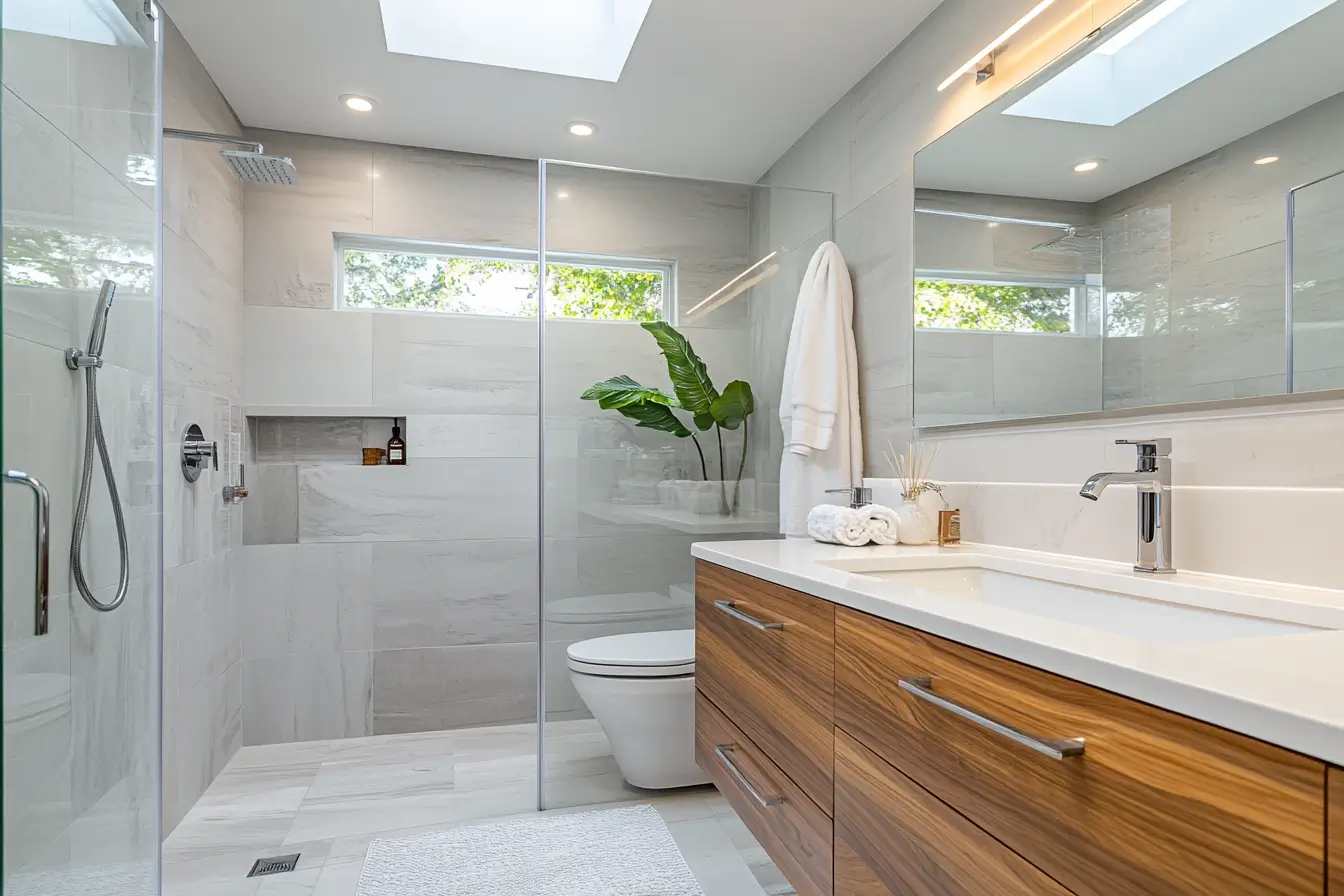
Introduction
Imagine stepping into your bathroom and feeling a sense of spaciousness and calm, despite its compact size. The tiles gleam, the fixtures shine, and every inch serves a purpose. This isn't a far-off dream—it's the potential outcome of a well-planned small bathroom remodel.
Small bathroom remodeling is more than just a fresh coat of paint or a new shower curtain. It's a comprehensive process of reimagining and renovating your existing bathroom to maximize space, improve functionality, and enhance aesthetics. Whether you're dealing with a cramped powder room or a tight full bath, a thoughtful renovation can transform your small bathroom from a challenging space into a efficient and stylish oasis.
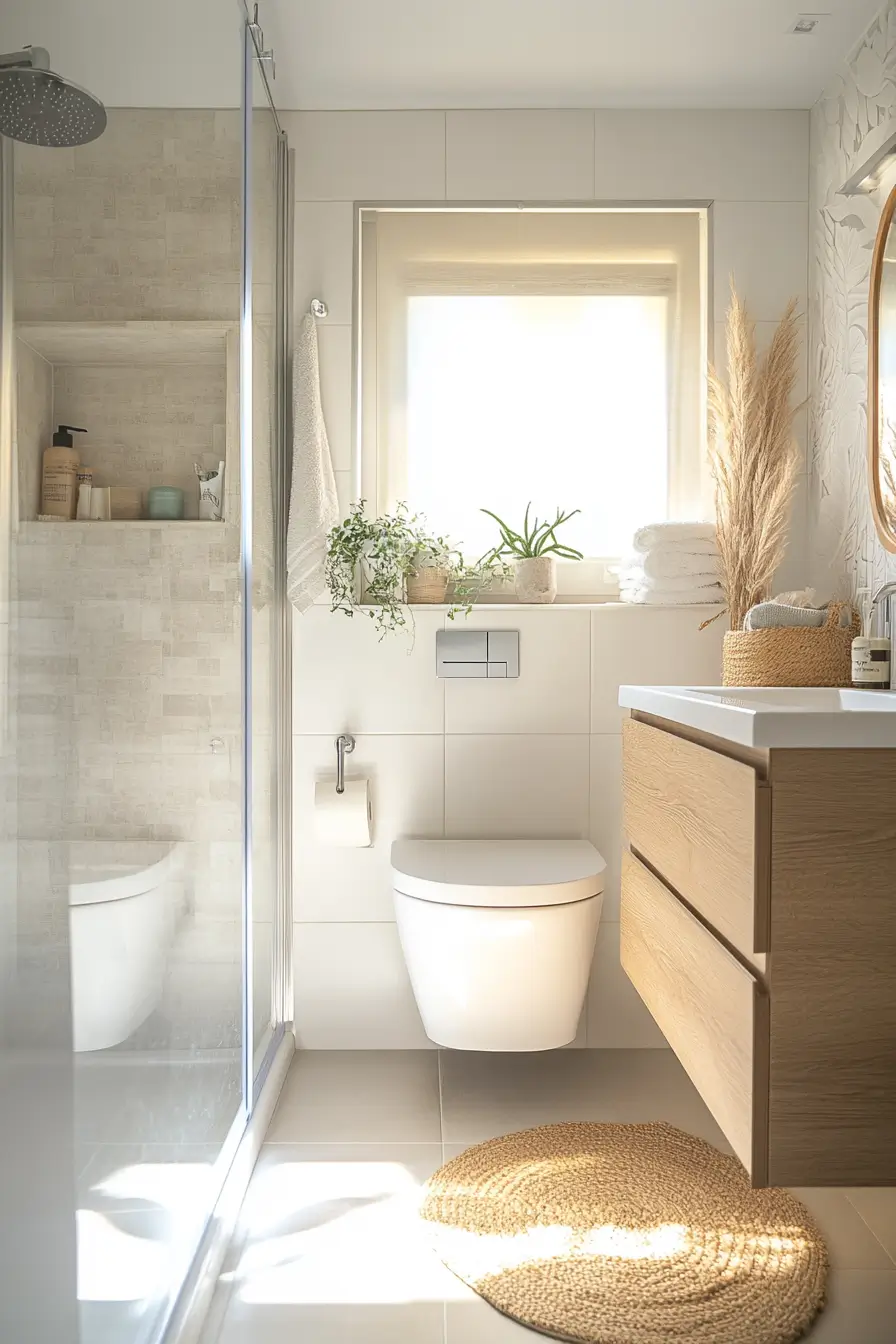
Why Consider Small Bathroom Remodeling?
- Increased Home Value: A updated bathroom can significantly boost your home's resale value. According to Remodeling Magazine's Cost vs. Value report, minor bathroom remodels typically recoup about 60-70% of their cost in increased home value.
- Improved Functionality: Smart remodeling choices can make your daily routines smoother and more enjoyable. Imagine having a place for everything and no more cramped shower experiences.
- Enhanced Aesthetics: A well-designed bathroom can become a retreat within your home, offering a spa-like experience even in a small space.
- Energy Efficiency: Modern fixtures and appliances can significantly reduce water and energy consumption, leading to lower utility bills.
- Personalization: A remodel allows you to tailor the space to your specific needs and preferences, from clever small bathroom storage solutions to accessibility features.

Key Considerations for Small Bathroom Remodels
When approaching a small bathroom renovation, keep these factors in mind:
- Space Optimization: Every inch counts in a small bathroom. Consider space-saving fixtures and clever storage solutions.
- Lighting: Good lighting can make a small space feel larger and more inviting. Think about layering different types of lighting for the best effect.
- Ventilation: Proper ventilation is crucial in a small bathroom to prevent moisture buildup and mold growth.
- Materials: Choose materials that are durable, easy to clean, and can withstand high moisture levels.
- Budget: Determine your budget early and prioritize improvements that offer the best value for your investment.
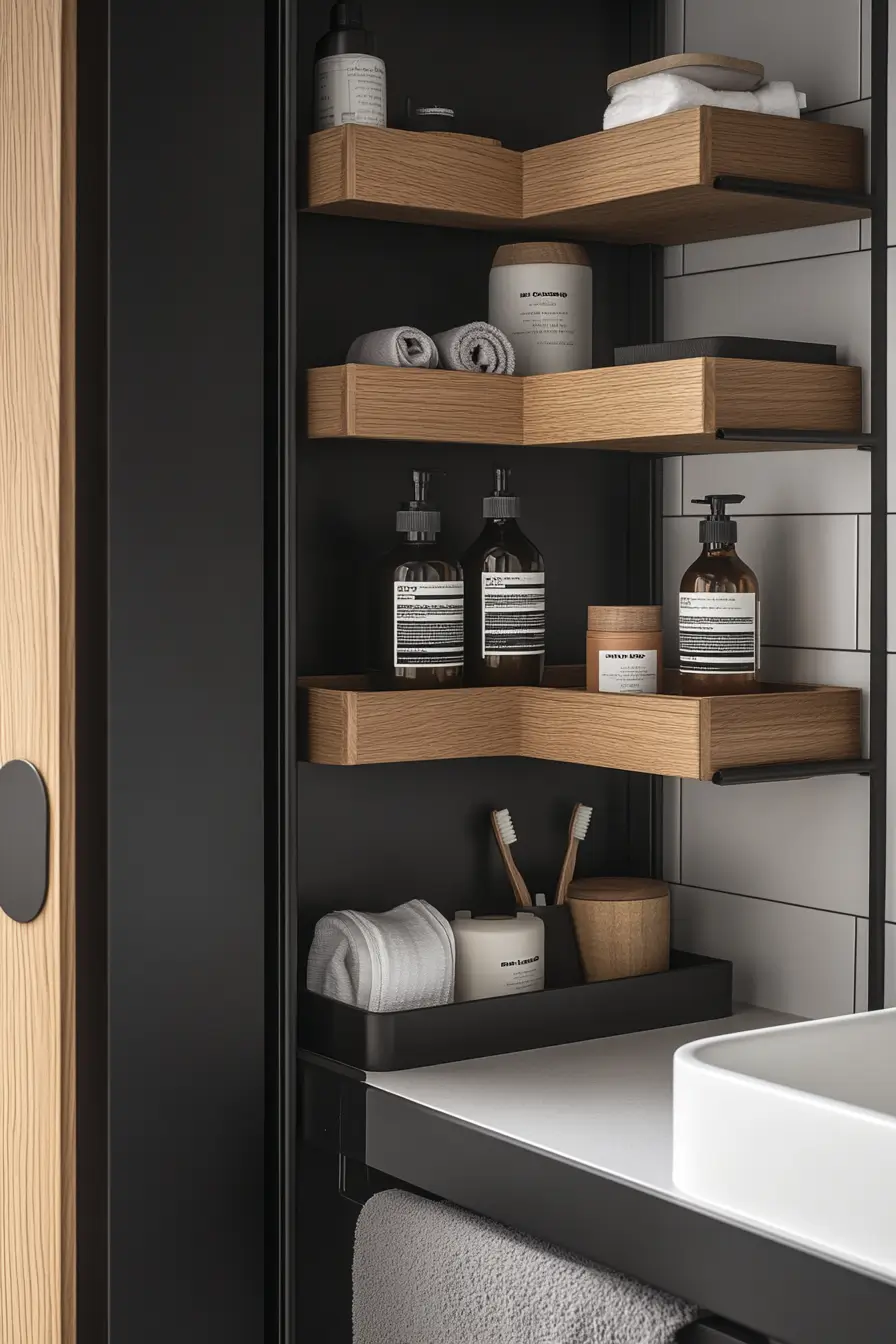
As we check out the world of small bathroom remodeling, we'll explore innovative ideas, practical tips, and expert advice to help you transform your compact bathroom into a space that feels both luxurious and functional. Whether you're planning a DIY refresh or a full professional renovation, this guide will equip you with the knowledge to make informed decisions and create a bathroom that exceeds your expectations.
II. Planning Your Small Bathroom Remodel
Picture this: You're standing in your small bathroom, armed with a tape measure and a notebook, ready to turn your renovation dreams into reality. But where do you start? Planning is the foundation of any successful remodel, especially when working with limited space. Let's break down the planning process into manageable steps that will set you up for success.

A. Assessing Your Current Space
Before you start tearing out tiles or shopping for new fixtures, it's crucial to understand your current bathroom's strengths and weaknesses.
- Identify Pain Points:
- Make a list of what's not working in your current bathroom. Is storage an issue? Is the lighting inadequate?
- Example: Sarah realized her biggest frustration was the lack of counter space around her sink.
- Measure and Create a Floor Plan:
- Measure every inch of your bathroom, including the location of windows, doors, and existing plumbing.
- Use graph paper or a digital tool to create a to-scale floor plan.
- Pro Tip: Don't forget to measure the ceiling height, especially if you're considering overhead storage.
- Determine Must-Haves vs. Nice-to-Haves:
- Create two lists: essential improvements and wishlist items.
- Example: For Tom, a water-efficient toilet was a must-have, while heated floors were a nice-to-have.

B. Setting a Realistic Budget
Money matters, especially in small bathroom remodels where every dollar should maximize impact.
- Average Costs for Small Bathroom Remodels:
- According to HomeAdvisor, the average bathroom remodel costs between $6,000 and $15,000.
- Small bathrooms (under 50 square feet) typically range from $5,000 to $8,000.
- Cost Breakdown by Project Areas:
- Labor: 40-65% of total cost
- Materials: 30-50% of total cost
- Fixtures: 15-25% of total cost
- Tip: Always set aside 10-20% of your budget for unexpected issues or last-minute changes.
- Tips for Saving Money Without Compromising Quality:
- Keep plumbing fixtures in place to avoid costly plumbing relocation.
- Consider refinishing existing tubs or shower basins instead of replacing them.
- Shop for floor model fixtures or during holiday sales for discounts.
- DIY what you can, but know when to call in professionals.
C. Timeline Considerations
Time is of the essence, especially when you're renovating your home's only bathroom.
- Typical Duration for Small Bathroom Renovations:
- On average, a small bathroom remodel takes 2-3 weeks.
- Full gut renovations can take 4-6 weeks.
- Factors That Can Affect Timeline:
- Availability of materials and fixtures
- Complexity of the project (e.g., moving plumbing or electrical)
- Permits and inspections
- Unexpected issues discovered during demolition
- Planning for Temporary Bathroom Alternatives:
- If it's your only bathroom, consider:
- Renting a portable toilet
- Using a neighbor's or nearby gym's facilities
- Staying with friends or family during the most disruptive phases
- Tip: Create a detailed schedule with your contractor and discuss how to minimize downtime.
- If it's your only bathroom, consider:
Remember, proper planning is the key to a smooth and successful small bathroom remodel. By thoroughly assessing your space, setting a realistic budget, and considering timeline factors, you'll be well-prepared to transform your small bathroom into the efficient, stylish space you've been dreaming of.

Let's go on this renovation journey together, turning the challenges of a small bathroom into opportunities for creative and impactful small bathroom design solutions.
III. Small Bathroom Renovation Styles and Trends
As you flip through home design magazines or scroll through Instagram, you might wonder, "How can I bring these stunning bathroom styles into my compact space?" The good news is that a small bathroom can be just as stylish and on-trend as its larger counterparts. Let's explore some popular small bathroom renovation styles and trends that can transform your space from lackluster to luxurious.

A. Modern Minimalism
The "less is more" philosophy works wonders in small bathrooms, creating a sense of spaciousness and serenity.
Key Elements:
- Sleek fixtures with clean lines
- Neutral color palette (whites, grays, blacks)
- Hidden storage to reduce visual clutter
- Large-format tiles or seamless surfaces
Practical Tip: Opt for wall-mounted vanities and toilets to create the illusion of more floor space.

B. Rustic Charm
Bring warmth and character to your small bathroom with rustic elements that create a cozy, cabin-like feel.
Key Elements:
- Natural materials like wood and stone
- Vintage-inspired fixtures (e.g., clawfoot tub, brass faucets)
- Earthy color palette (warm browns, greens, blues)
- Textured surfaces (e.g., wood-look tiles, pebble shower floors)
Practical Tip: Use reclaimed wood for shelving or a vanity top to add authentic rustic charm without overwhelming the space.

C. Spa-Inspired Retreats
Transform your small bathroom into a personal oasis with spa-like elements that promote relaxation.
Key Elements:
- Calming color scheme (soft blues, greens, or neutral tones)
- Natural materials like bamboo or teak
- Luxurious touches (e.g., rainfall showerhead, heated towel rack)
- Plenty of soft, plush textiles
Practical Tip: Install a small water feature or bring in some low-maintenance plants to enhance the spa-like atmosphere.

D. Bold and Eclectic
Don't be afraid to make a statement in your small bathroom. Bold choices can turn a tiny space into a jewel box of personality.
Key Elements:
- Vibrant wallpaper or statement tiles
- Mix of patterns and textures
- Unexpected color combinations
- Unique fixtures or accessories (e.g., colorful sink, ornate mirror)
Practical Tip: Use bold elements sparingly. In a small space, a little goes a long way. Consider a statement wall or floor, balanced with more neutral elements elsewhere.

A. Scandinavian Serenity
Embrace the Nordic principle of "hygge" (coziness and comfort) in your small bathroom.
Key Elements:
- Light wood tones (birch, ash, or pine)
- Crisp white walls with pops of soft pastels
- Minimalist fixtures with organic shapes
- Cozy textiles like woven bath mats and linen towels
Practical Tip: Incorporate a small wooden stool or bench to add warmth and functionality.

B. Art Deco Glamour
Channel the roaring twenties with the luxurious and geometric style of Art Deco.
Key Elements:
- Bold geometric patterns in tiles or wallpaper
- Rich, jewel-toned color palette (emerald green, sapphire blue, gold)
- Mirrors with sunburst or geometric frames
- Chrome or brass fixtures with sleek lines
Practical Tip: Use large-scale patterns on one wall or the floor to make a statement without overwhelming the space.

C. Zen Japanese Retreat
Create a sense of tranquility with elements inspired by traditional Japanese bathrooms.
Key Elements:
- Natural materials like bamboo, cedar, and stone
- Soaking tub or oversized shower with a wooden stool
- Shoji screen-inspired glass partitions
- Minimalist fixtures and accessories
Practical Tip: Install a small fountain or water feature to add a soothing auditory element.

D. Industrial Chic
Embrace the raw beauty of industrial elements for a modern, edgy bathroom.
Key Elements:
- Exposed brick walls or concrete surfaces
- Metal fixtures with a matte black or brushed steel finish
- Edison bulb lighting or cage pendant lights
- Repurposed materials (e.g., pipe shelving, reclaimed wood vanity)
Practical Tip: Balance industrial elements with softer textures like plush towels or a fabric shower curtain to avoid a cold feel.

E. Coastal Retreat
Bring the relaxed vibes of the beach into your small bathroom.
Key Elements:
- Sandy neutrals with shades of blue and aqua
- Weathered wood elements or white-washed finishes
- Textured tiles reminiscent of sea glass or sand
- Nautical accents like rope mirrors or seashell decor
Practical Tip: Use glass jars filled with sand and seashells as decorative storage for small items.

F. Bohemian Eclectic
Embrace a free-spirited, globally-inspired aesthetic in your small bathroom.
Key Elements:
- Mix of patterns and textures (e.g., Moroccan tiles, tribal prints)
- Rich, warm color palette with jewel-tone accents
- Vintage or handcrafted fixtures and accessories
- Plants and natural elements for a lush feel
Practical Tip: Use a vibrant, patterned shower curtain as a focal point to add personality without permanent commitments.

G. Minimalist Wabi-Sabi
Embrace the beauty of imperfection with this Japanese-inspired aesthetic.
Key Elements:
- Natural, unrefined materials like unpolished stone or raw wood
- Neutral color palette with earthy tones
- Simple, asymmetrical designs
- Handcrafted elements with visible textures
Practical Tip: Choose fixtures and materials with organic, imperfect finishes to embody the wabi-sabi philosophy.

Incorporating Trends in Small Bathroom Renovations
While these styles offer a great starting point, consider these current bathroom renovation trends to add functionality and value:
- Biophilic Design: Incorporate living walls, natural materials, and ample natural light to connect with nature.
- Smart Storage Solutions: Utilize every inch with custom built-ins, magnetic walls for metal accessories, or hidden compartments.
- Statement Ceilings: Draw the eye upward with bold wallpaper, unique paint colors, or interesting textures on the ceiling.
- Vintage Meets Modern: Mix vintage-inspired fixtures with modern technology for a unique blend of old and new.
- Wellness Features: Install chromotherapy lighting, aromatherapy diffusers, or a small sauna for a spa-like experience.
Remember, the key to a successful small bathroom renovation is choosing a style that resonates with you while maximizing functionality. Whether you're drawn to the serenity of Scandinavian design or the boldness of Art Deco, there's a perfect style to make your small bathroom feel like a personal sanctuary.
IV. Innovative Remodeling Ideas for Small Bathrooms
Imagine walking into a bathroom showroom, surrounded by sprawling layouts and luxurious features. You might think, "These ideas would never work in my space." But what if we told you that with a bit of creativity and some clever design tricks, you could bring that same sense of luxury and innovation to your compact bathroom? Let's explore some cutting-edge remodeling ideas that can transform your small bathroom into a space that feels both expansive and indulgent.
A. Space-Expanding Illusions
Create the illusion of a larger bathroom with these clever visual tricks:
- Large-Format Tiles for Seamless Surfaces
- Use 24x24 inch or larger tiles on floors and walls
- Opt for rectified tiles with minimal grout lines
- Consider continuing the same tile from floor to shower for a unified look
- Strategic Mirror Placement
- Install a full-wall mirror to double the perceived space
- Use mirrored cabinet doors for both storage and reflection
- Consider a backlit mirror for added depth and ambiance
- Optical Illusions Through Patterns
- Use horizontal stripes to visually widen the room
- Implement diagonal floor patterns to elongate the space
- Experiment with ombre wall tiles for a sense of receding space
Practical Tip: Pair large-format tiles with a monochromatic color scheme to maximize the space-expanding effect.

B. Multifunctional Fixtures
Make every inch count with fixtures that serve multiple purposes:
- Toilet-Sink Combos
- Install a toilet with an integrated sink on the tank lid
- Save water by using sink greywater to fill the toilet tank
- Ideal for powder rooms or extremely tight spaces
- Convertible Bathtub-Shower Units
- Choose a tub with a removable or folding glass enclosure
- Opt for a deep soaking tub that doubles as a comfortable shower space
- Consider a tub with built-in shelving or seating for added functionality
- Foldable or Retractable Features
- Install a wall-mounted, fold-down shower seat
- Use a retractable clothesline for drying delicates
- Consider a fold-down makeup station or work surface
Practical Tip: When selecting multifunctional fixtures, prioritize quality and durability to ensure long-term functionality in a high-use space.

C. Smart Storage Solutions
Maximize storage in your small bathroom with these innovative ideas:
- Custom-Built Niches and Recessed Shelving
- Create shower niches for toiletries and accessories
- Install recessed medicine cabinets for hidden storage
- Utilize space between wall studs for narrow, built-in shelving
- Utilizing Awkward Corners and Spaces
- Install corner shelves or a corner sink to maximize odd angles
- Use over-toilet storage units or shelving for vertical space
- Implement pull-out organizers in narrow spaces beside fixtures
- Hidden Storage Ideas
- Choose vanities with tip-out front panels for extra storage
- Install a mirror that slides to reveal hidden shelving behind
- Use magnetic strips inside cabinet doors for metal grooming tools
Practical Tip: Conduct a "storage audit" of your daily bathroom items to customize storage solutions that fit your specific needs.

D. Tech Integration in Small Bathroom Remodels
Bring your small bathroom into the future with these high-tech upgrades:
- Smart Toilets and Bidets
- Install a compact smart toilet with built-in bidet functionality
- Choose models with automatic lids, seat warming, and self-cleaning features
- Consider toilets with water-saving dual flush technology
- Digital Shower Systems
- Implement a digital shower control for precise temperature and flow settings
- Choose systems with presets for multiple users
- Look for models with voice activation or smartphone control
- Automated Lighting and Climate Control
- Install motion-sensor lighting for energy efficiency
- Use smart mirrors with integrated lighting and defoggers
- Implement underfloor heating controlled by smart thermostats
Practical Tip: When adding tech features, ensure your bathroom's electrical system can handle the increased load and that all installations are properly waterproofed.

Remember, innovative small bathroom remodeling is about thinking creatively and making the most of every square inch. By incorporating space-expanding illusions, multifunctional fixtures, smart storage solutions, and cutting-edge technology, you can create a bathroom that feels spacious, luxurious, and perfectly tailored to your needs. The key is to carefully consider your specific requirements and choose solutions that offer the best balance of functionality and style for your unique space.

V. Tackling Common Small Bathroom Remodeling Challenges
You've decided to take the plunge and remodel your small bathroom. As you begin, you might find yourself facing a series of unexpected hurdles. Perhaps the room feels like a cave, or you're constantly battling moisture issues. Don't worry – you're not alone. Many homeowners encounter these common challenges when remodeling small bathrooms. Let's explore practical solutions to transform these obstacles into opportunities for creative design.

A. Dealing with Limited Natural Light
A dark, cave-like bathroom can feel claustrophobic. Here's how to brighten up your space:
- Skylight Installation Options
- Consider tubular skylights for minimal roof interference
- Install a traditional skylight for maximum natural light
- Explore solar-powered options with built-in blinds for control
- Light Tubes and Sun Tunnels
- Use reflective tubing to channel light from roof to ceiling
- Ideal for bathrooms on lower floors of multi-story homes
- Choose models with integrated night lighting for 24/7 illumination
- Maximizing Artificial Lighting
- Layer lighting with ambient, task, and accent sources
- Install dimmer switches for customizable brightness
- Use LED strip lighting under vanities or along baseboards
Practical Tip: When installing new lighting, consider the color temperature. Warm light (2700-3000K) is flattering for skin tones, while cool light (3500-4100K) is energizing and great for task areas.

B. Improving Ventilation
Proper ventilation is crucial in small bathrooms to prevent moisture-related issues. Here's how to keep your bathroom fresh and dry:
- Upgrading Exhaust Fans
- Choose a fan with appropriate CFM (cubic feet per minute) for your bathroom size
- Look for models with humidity sensors for automatic operation
- Consider fans with built-in heating or lighting for multifunctionality
- Adding Windows or Vents
- Install a window in the shower area for natural ventilation
- Consider awning windows for ventilation even during light rain
- Use wall vents in conjunction with exhaust fans for improved air circulation
- Moisture-Resistant Materials
- Select mold-resistant drywall for areas prone to moisture
- Use porcelain or ceramic tiles for water-resistant flooring and walls
- Apply anti-microbial grout sealers to prevent mold growth
Practical Tip: Run your exhaust fan during showers and for at least 30 minutes afterward to effectively remove moisture from the air.

C. Maximizing Vertical Space
When floor space is at a premium, look up! Vertical space can be a game-changer in small bathroom remodels:
- Floor-to-Ceiling Storage Solutions
- Install tall, narrow cabinets for maximum storage capacity
- Use open shelving units to create an airy feel while adding storage
- Consider a floor-to-ceiling linen closet for towels and toiletries
- Utilizing Door Space
- Hang over-the-door organizers for additional storage
- Install hooks or racks on the back of the bathroom door
- Consider a sliding barn door with built-in shelving
- Vertical Radiator and Towel Warmer Options
- Replace traditional radiators with sleek, vertical models
- Install heated towel racks that double as room heaters
- Use wall-mounted, ladder-style towel warmers for a modern look
Practical Tip: When adding vertical storage, use baskets or decorative boxes on higher shelves to store less-frequently used items while maintaining a tidy appearance.

D. Overcoming Plumbing Constraints
Existing plumbing can often dictate layout in small bathroom remodels, but there are ways to work around these constraints:
- Options for Moving Plumbing Fixtures
- Consider above-floor macerating toilets for flexibility in placement
- Use wall-mounted faucets to free up counter space
- Explore curved or offset drain pipes to accommodate new layouts
- Dealing with Old Pipes
- Inspect existing pipes and replace corroded or damaged sections
- Use pipe relining techniques for less invasive repairs
- Consider updating to PEX piping for improved flexibility and durability
- Space-Saving Plumbing Solutions
- Install wall-hung toilets with in-wall tanks to save floor space
- Use corner sinks to maximize awkward spaces
- Opt for a linear shower drain to allow for a curbless shower design
Practical Tip: Always consult with a licensed plumber before making significant changes to your bathroom's plumbing layout to ensure compliance with local codes and regulations.
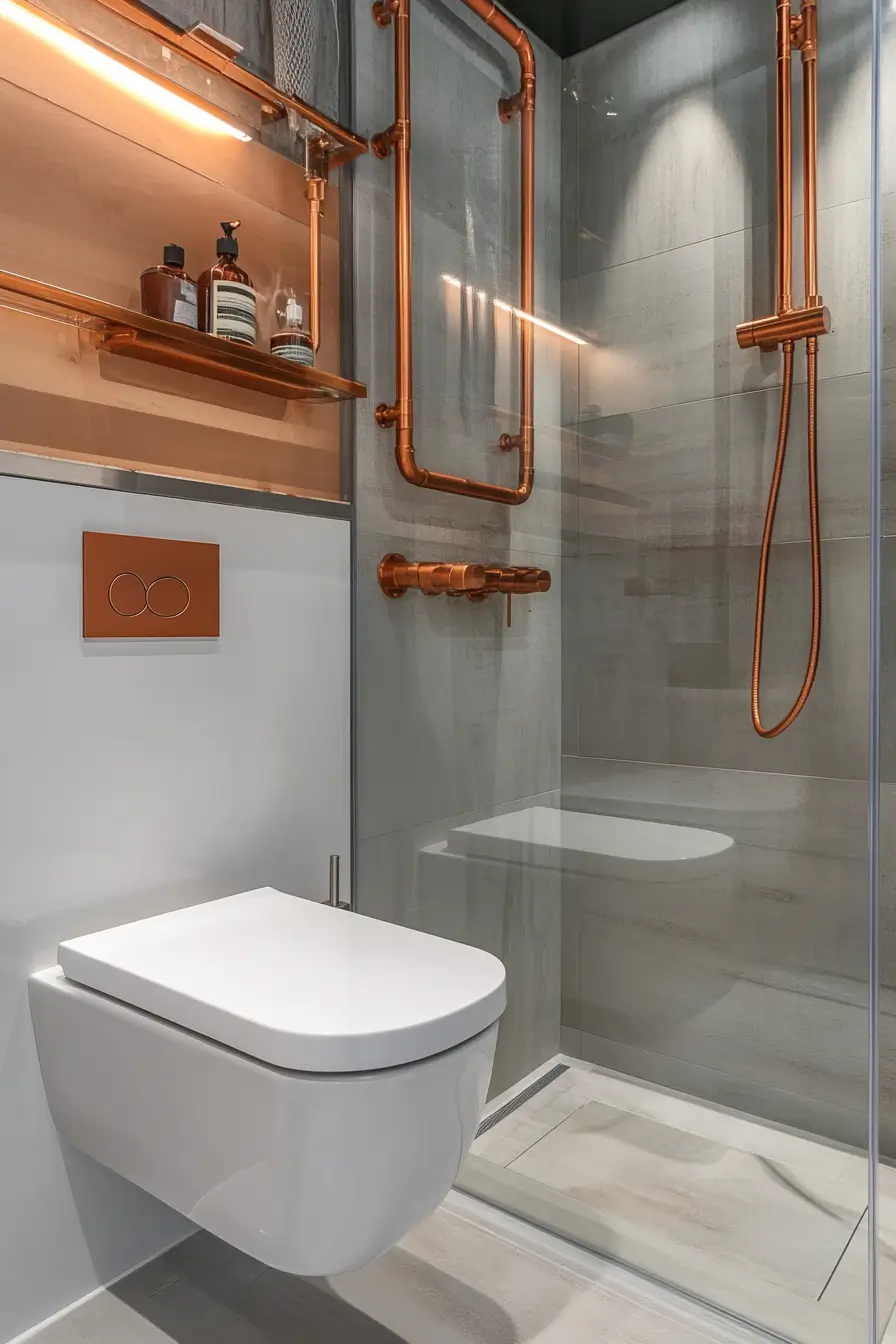
Remember, every challenge in small bathroom remodeling is an opportunity for creative problem-solving. By addressing issues of lighting, ventilation, space utilization, and plumbing constraints head-on, you can create a small bathroom that feels spacious, fresh, and perfectly tailored to your needs. The key is to approach each challenge with an open mind and a willingness to explore innovative solutions.

VI. Eco-Friendly Small Bathroom Renovations
As you reach for the faucet in your soon-to-be-renovated bathroom, you pause and wonder: "How can I make this space not just beautiful, but also kind to the environment?" You're not alone in this thought. More and more homeowners are seeking ways to combine style with sustainability in their small bathroom renovations. Let's explore how you can create an eco-friendly oasis that's good for both you and the planet.
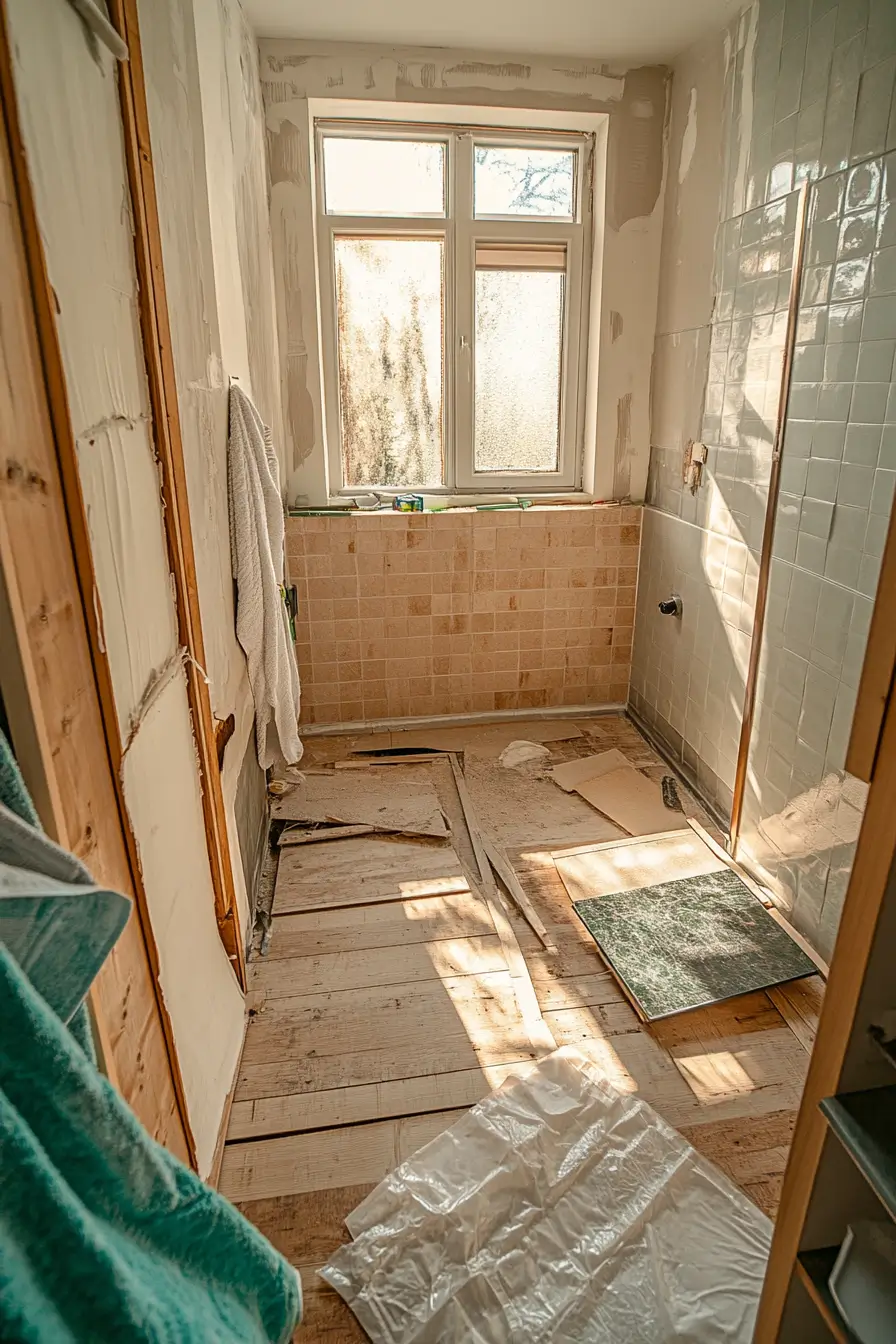
A. Water-Saving Fixtures
Conserving water is a cornerstone of eco-friendly bathroom design. Here's how you can reduce water usage without sacrificing comfort:
- Low-Flow Toilets and Faucets
- Install dual-flush toilets to use less water for liquid waste
- Choose faucets with aerators to maintain pressure while reducing flow
- Look for WaterSense-labeled products for certified efficiency
- Greywater Systems for Small Spaces
- Implement a sink-to-toilet system that uses handwashing water to fill the toilet tank
- Consider a compact greywater filtration system for watering plants
- Explore shower water recirculation systems for significant water savings
- Rainwater Harvesting on a Small Scale
- Install a small rainwater collection system on your roof
- Use collected rainwater for toilet flushing or plant watering
- Consider a compact rain barrel for outdoor use connected to your bathroom
Practical Tip: Start with simple changes like installing a low-flow showerhead, which can save up to 2,700 gallons of water per year for the average family.

B. Energy-Efficient Upgrades
Reducing energy consumption is another key aspect of an eco-friendly bathroom renovation:
- LED Lighting Options
- Replace traditional bulbs with LED alternatives
- Install dimmer switches to further reduce energy usage
- Use motion sensors for automatic shut-off when the bathroom is unoccupied
- Energy-Efficient Ventilation Systems
- Choose ENERGY STAR certified exhaust fans
- Install fans with humidity sensors for optimal operation
- Consider heat recovery ventilators for energy-efficient air exchange
- Solar-Powered Bathroom Accessories
- Use solar-powered toothbrush chargers and shavers
- Install a small solar panel to power bathroom lighting
- Consider solar water heating for your shower
Practical Tip: When selecting new appliances or fixtures, always look for the ENERGY STAR label to ensure you're choosing energy-efficient options.
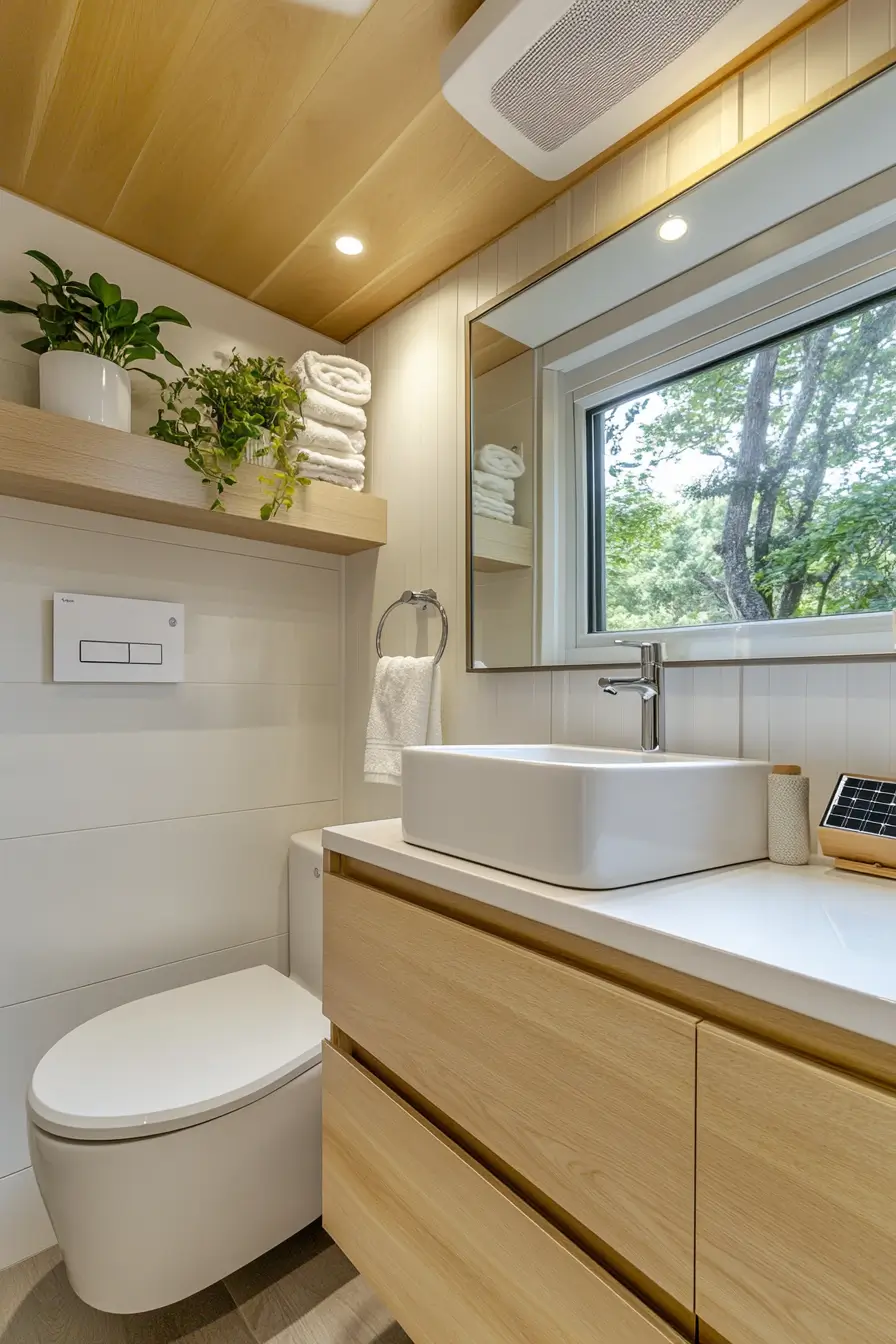
C. Sustainable Materials for Small Bathroom Remodels
Choosing eco-friendly materials can significantly reduce your bathroom's environmental impact:
- Recycled Glass Countertops and Tiles
- Use recycled glass mosaic tiles for a unique, sustainable backsplash
- Choose countertops made from recycled glass and concrete composite
- Consider recycled glass shower doors for a modern, eco-friendly touch
- Bamboo and Cork Flooring Options
- Install bamboo flooring for a sustainable, water-resistant option
- Use cork tiles for a soft, warm feel underfoot
- Consider engineered wood with a sustainable forestry certification
- Low-VOC Paints and Finishes
- Choose paints with low volatile organic compounds (VOCs) for better air quality
- Use natural oil finishes on wood elements
- Select low-VOC sealants and adhesives for all bathroom installations
Practical Tip: When selecting bamboo products, look for those certified by the Forest Stewardship Council (FSC) to ensure sustainable harvesting practices.

D. Eco-Friendly Renovation Practices
The renovation process itself can be made more environmentally friendly:
- Waste Reduction and Recycling
- Donate usable fixtures and materials to local charities or resale shops
- Separate renovation waste for proper recycling
- Choose contractors who practice responsible waste management
- Locally Sourced Materials and Labor
- Use materials sourced from local suppliers to reduce transportation emissions
- Hire local contractors and artisans to support the community and reduce travel
- Consider salvaged materials from local architectural salvage yards
- Non-Toxic Cleaning and Maintenance
- Use natural, biodegradable cleaning products
- Implement a vinegar and water solution for daily cleaning
- Choose microfiber cloths over disposable wipes for regular maintenance
Practical Tip: Create a detailed plan before starting your renovation to minimize waste and avoid unnecessary purchases or rework.
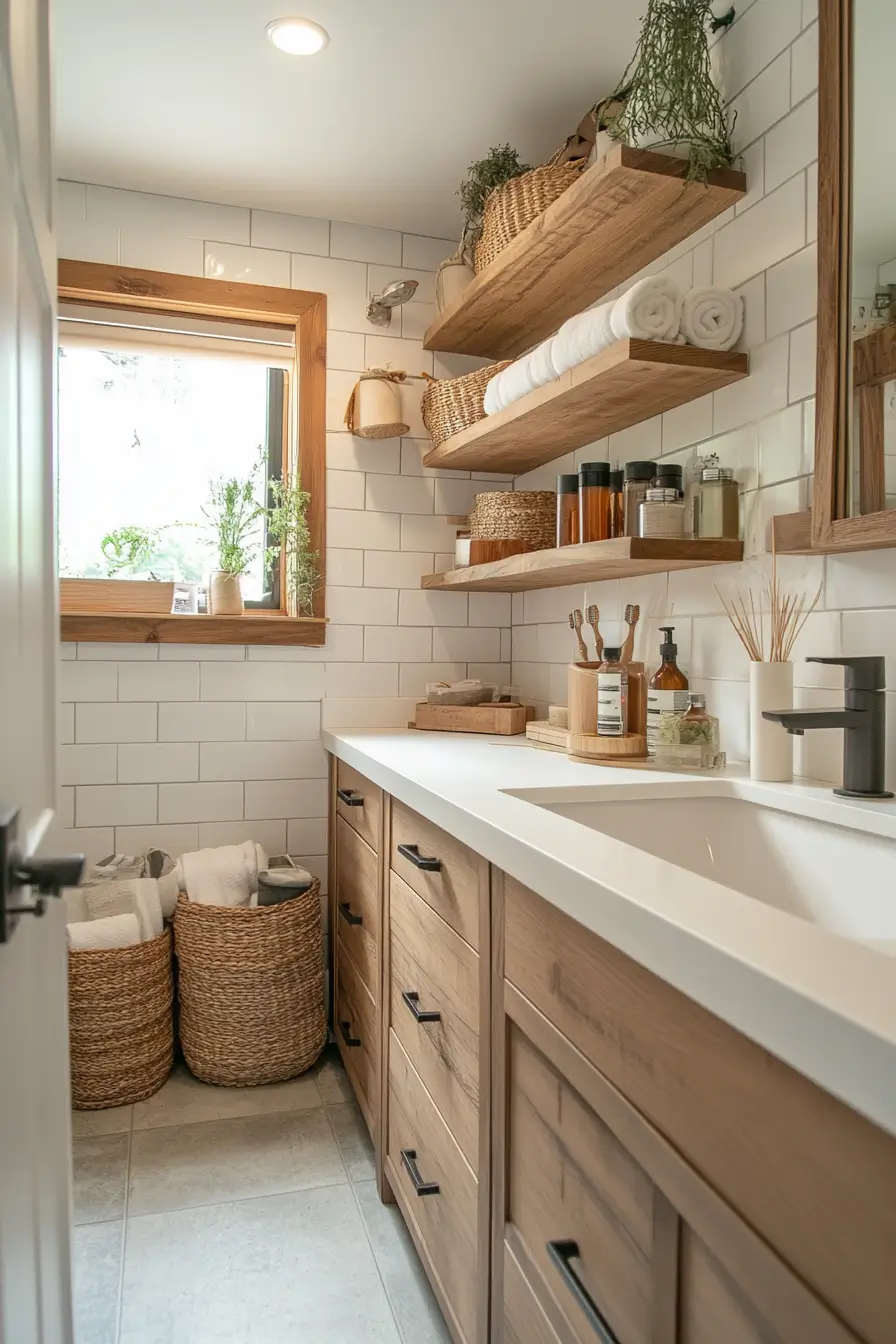
Remember, creating an eco-friendly small bathroom isn't just about using green products – it's about adopting a holistic approach to sustainability. By incorporating water-saving fixtures, energy-efficient upgrades, sustainable materials, and eco-friendly renovation practices, you can create a bathroom that's not only beautiful and functional but also kind to the environment. Every small choice adds up, making your bathroom renovation a step towards a more sustainable future.

VII. DIY vs. Professional: Making the Right Choice for Your Remodel
You're standing in your bathroom, armed with a Pinterest board full of inspiration and a determination to transform the space. The big question looms: should you roll up your sleeves and tackle this remodel yourself, or is it time to call in the professionals? This decision can significantly impact your project's timeline, budget, and outcome. Let's explore how to make the right choice for your small bathroom remodel.
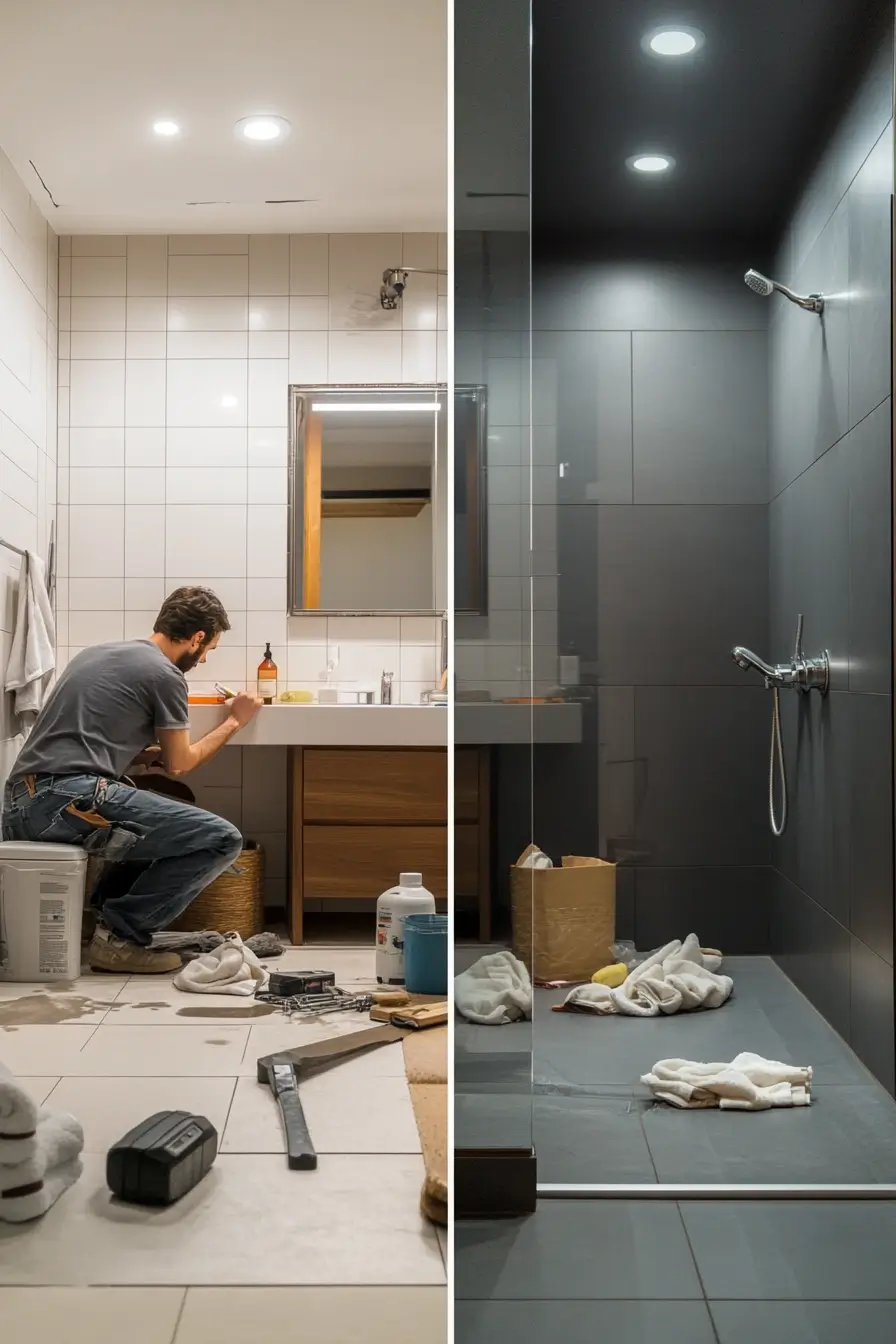
A. Assessing Your Skill Level
Before deciding between DIY and professional help, it's crucial to honestly evaluate your abilities and available time.
- DIY-Friendly Small Bathroom Updates
- Painting walls and cabinets
- Installing new hardware (towel bars, toilet paper holders)
- Replacing faucets or showerheads
- Updating light fixtures
- Installing a new toilet
- Projects That Typically Require Professionals
- Electrical work (moving outlets, installing new circuits)
- Plumbing changes (relocating fixtures, installing new pipes)
- Structural modifications (removing walls, changing layout)
- Tile work (especially intricate patterns or large areas)
- Shower or tub installation
- Hybrid Approaches: What You Can DIY and What to Leave to Pros
- DIY demolition, leave reconstruction to professionals
- Install fixtures yourself, hire pros for plumbing connections
- Paint and decorate after professionals handle major installations
Practical Tip: Start with small DIY projects to build confidence and skills before taking on larger tasks.

B. Hiring Contractors for Small Bathroom Renovations
If you decide to go the professional route, knowing how to find and work with contractors is key.
- Finding and Vetting Contractors
- Ask for recommendations from friends, family, or local home improvement stores
- Check online reviews and ratings on platforms like Angi or HomeAdvisor
- Verify licenses, insurance, and certifications
- Request and compare multiple bids
- Questions to Ask Potential Contractors
- How long have you been in business?
- Can you provide references for similar projects?
- What's your timeline for completion?
- How do you handle unexpected issues or changes?
- Will you obtain necessary permits?
- Understanding Quotes and Contracts
- Ensure quotes are detailed and itemized
- Look for specifics on materials, labor, and timeline
- Understand the payment schedule
- Check for warranties on work and materials
- Confirm details about clean-up and debris removal
Practical Tip: Always get at least three quotes from different contractors to compare prices and approaches.

C. Permits and Regulations
Whether DIY or professional, understanding local regulations is crucial for a smooth remodel.
- When Permits Are Required for Bathroom Renovations
- Structural changes (moving walls, adding windows)
- Electrical work (new circuits, moving outlets)
- Plumbing modifications (relocating fixtures, adding new lines)
- Changes to ventilation systems
- Common Code Requirements for Small Bathroom Remodels
- Proper ventilation (often requiring an exhaust fan)
- GFCI outlets near water sources
- Specific clearances around fixtures (e.g., toilet placement)
- Water-resistant materials in shower/tub areas
- Working with Inspectors During Your Renovation
- Schedule inspections at key points in the project
- Prepare necessary documentation for each inspection
- Be present or have your contractor present during inspections
- Address any issues promptly to avoid delays
Practical Tip: Visit your local building department early in the planning process to understand all requirements for your specific project.
D. Weighing Costs: DIY vs. Professional
Understanding the true costs of both approaches can help you make an informed decision.
- DIY Cost Considerations
- Materials and tools (including rentals for specialized equipment)
- Potential mistakes and do-overs
- Time investment (including learning new skills)
- Possible decrease in home value if work isn't up to standard
- Professional Remodel Expenses
- Labor costs (typically 40-65% of total project cost)
- Higher-quality materials often available at contractor discounts
- Warranties on work and materials
- Faster completion time
- Long-Term Value Considerations
- Impact on home resale value
- Durability and longevity of the renovation
- Energy efficiency improvements
- Potential insurance implications
Practical Tip: Create a detailed budget for both DIY and professional scenarios, including a contingency fund for unexpected issues.
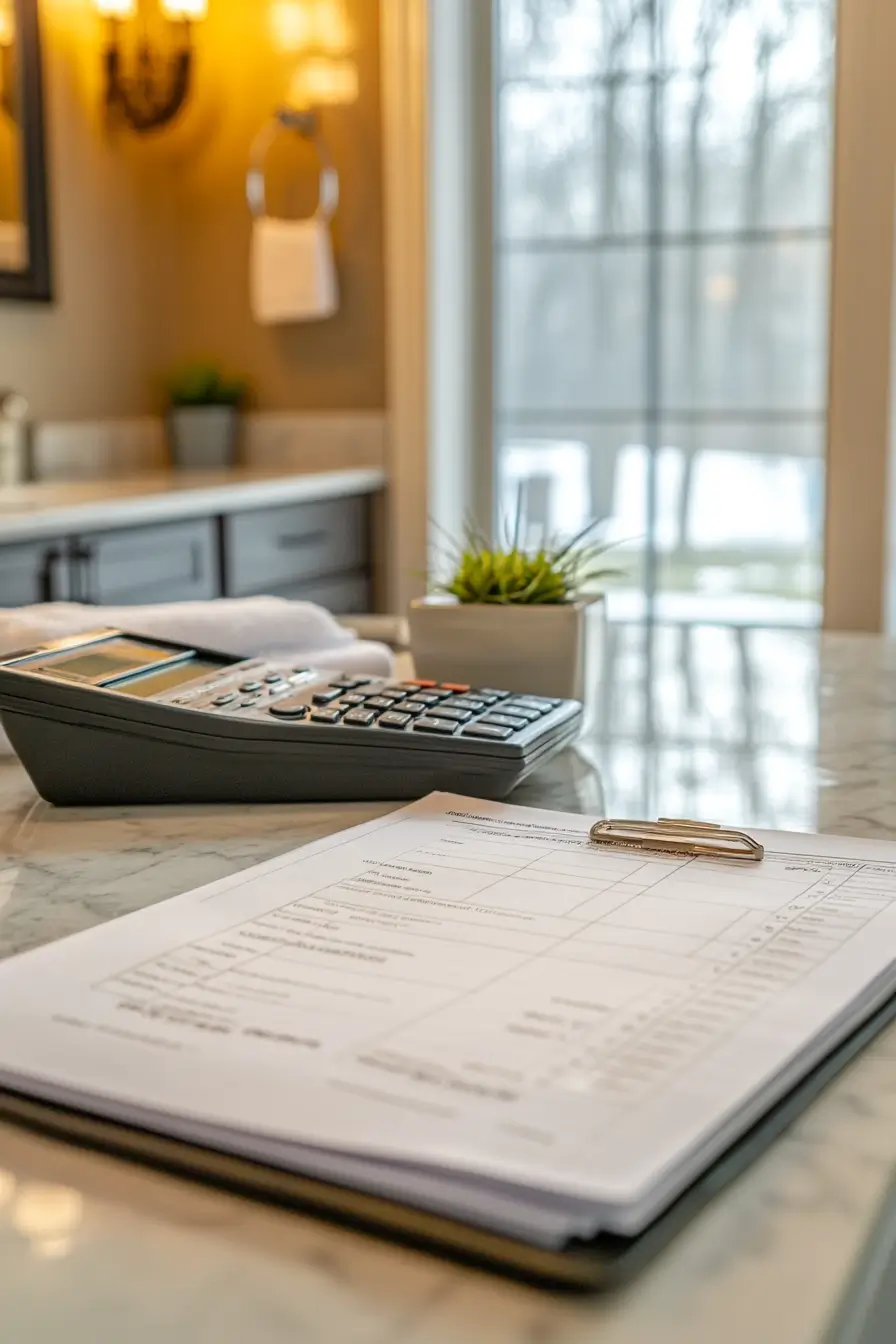
When deciding between DIY and professional help for your small bathroom remodel, consider your skills, time, budget, and the complexity of the project. There's no one-size-fits-all answer – the right choice depends on your unique situation. Remember, even if you choose to DIY, it's okay to call in professionals for complex tasks like electrical or plumbing work. The goal is to create a beautiful, functional bathroom that meets your needs and complies with local regulations, whether you do it yourself or hire experts to bring your vision to life.
IX. Post-Renovation Care and Maintenance
You step into your newly renovated bathroom, admiring the gleaming fixtures and pristine surfaces. It's a far cry from the dated space you started with, and you can't help but feel a sense of pride. But as you run your hand along the sleek countertop, a thought crosses your mind: "How do I keep it looking this good?" Maintaining your bathroom's fresh, new look is just as important as the renovation itself. Let's explore how to care for your revamped space and protect your investment.
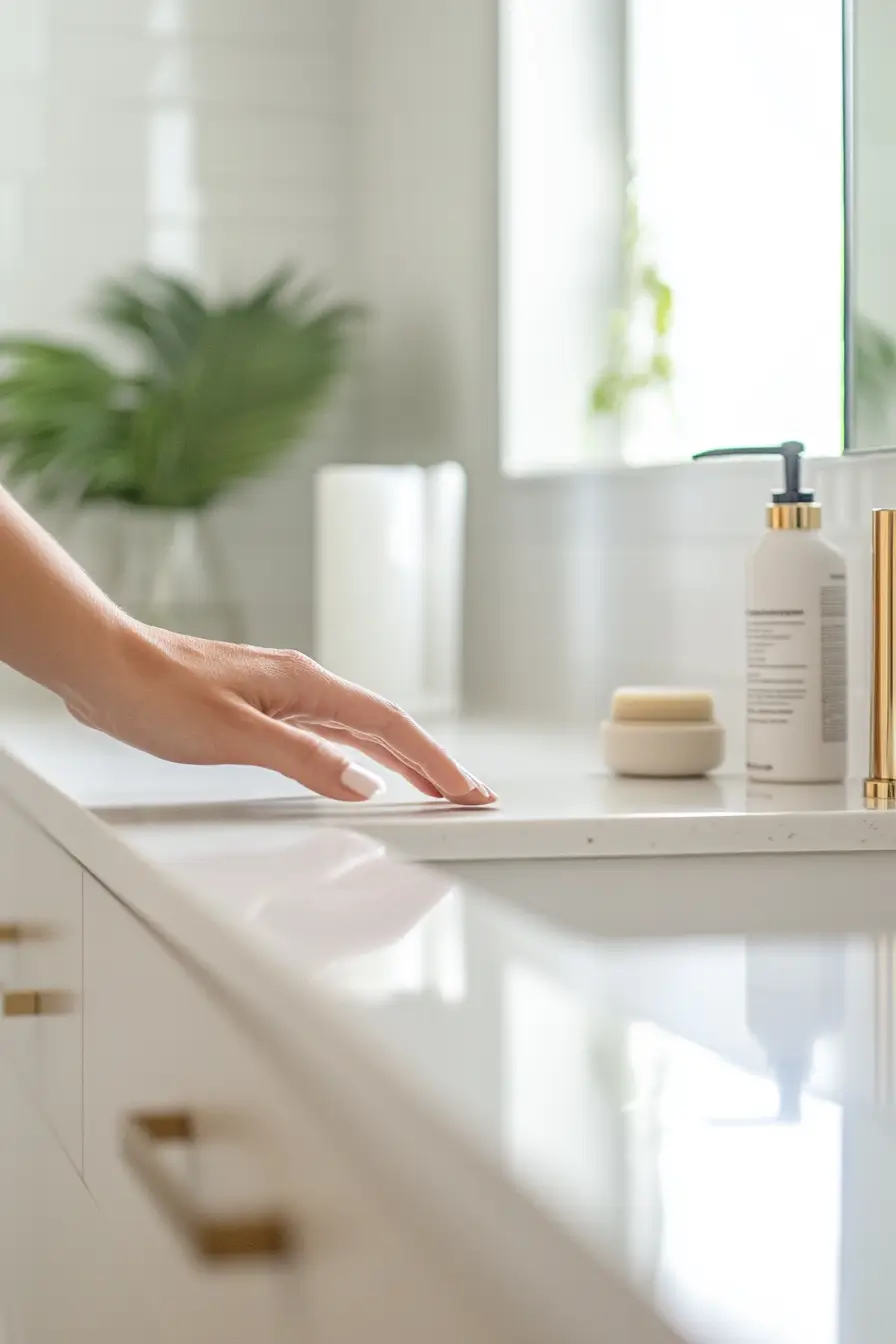
A. Cleaning Tips for New Bathroom Features
Keeping your renovated bathroom in top condition requires a tailored approach to cleaning and maintenance.
- Maintaining New Fixtures and Surfaces
- Glass shower doors: Squeegee after each use to prevent water spots and soap scum buildup
- Natural stone surfaces: Use pH-neutral cleaners to avoid etching or discoloration
- Matte finishes: Clean with soft microfiber cloths to prevent scratches
- High-tech fixtures: Follow manufacturer's instructions for cleaning smart toilets or digital shower systems
- Eco-Friendly Cleaning Solutions for Small Bathrooms
- All-purpose cleaner: Mix equal parts white vinegar and water in a spray bottle
- Tub and tile cleaner: Create a paste with baking soda and water for scrubbing
- Glass cleaner: Use a solution of one part water to one part white vinegar
- Drain maintainer: Pour 1/2 cup baking soda followed by 1/2 cup vinegar down drains monthly
- Preventive Maintenance to Protect Your Renovation Investment
- Seal grout lines annually to prevent water penetration and staining
- Check and replace caulk around tubs, showers, and sinks as needed
- Clean exhaust fan covers and test fan function regularly
- Inspect faucets and showerheads for leaks or mineral buildup
Practical Tip: Create a cleaning schedule that includes daily quick-cleans (wiping down surfaces) and weekly deep cleans to maintain your bathroom's new look with minimal effort.
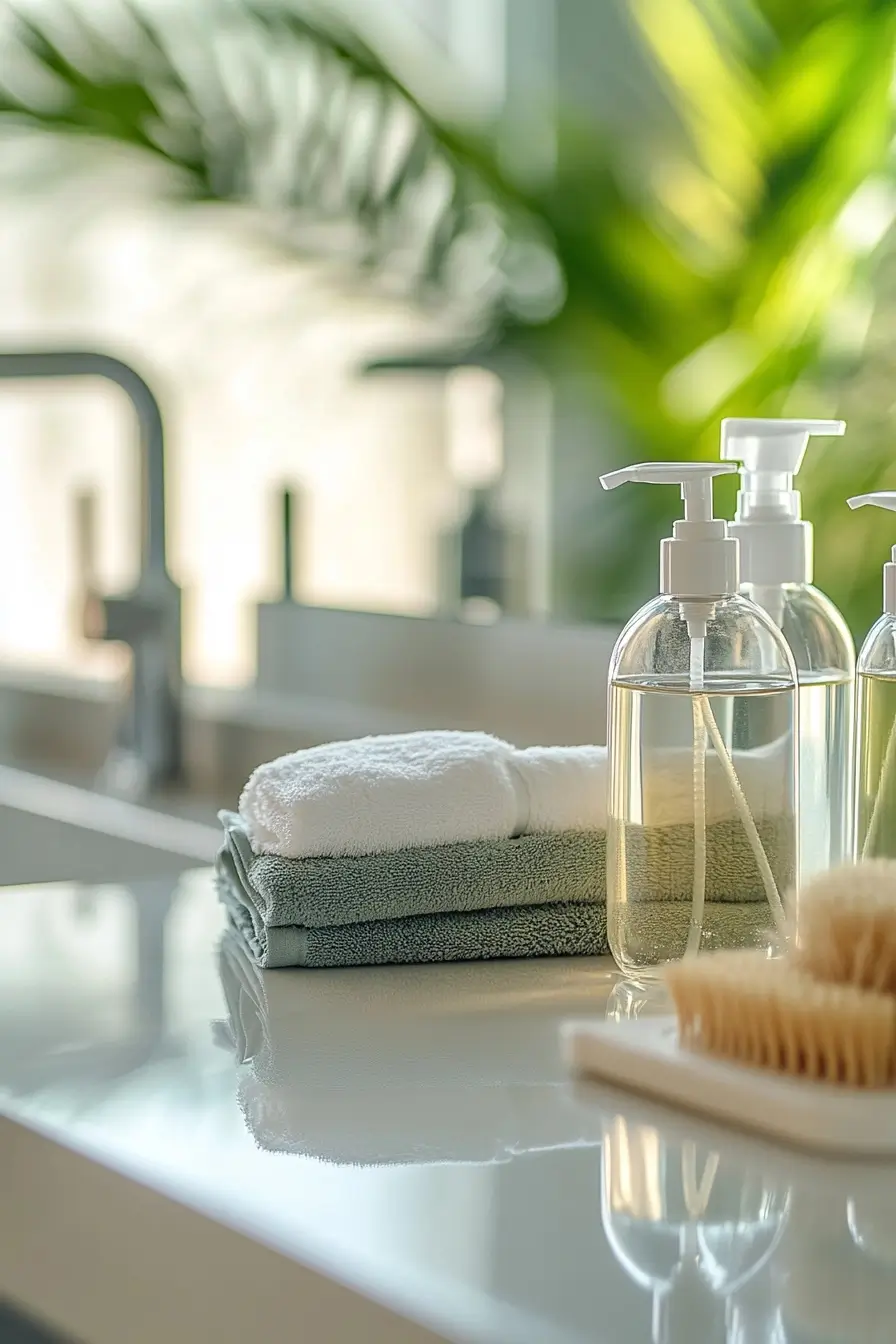
B. When to Consider Updates or Repairs
Even with proper care, your renovated bathroom may need occasional updates or repairs. Knowing when and how to address these issues can help maintain your bathroom's functionality and appearance.
- Signs It's Time for Touch-Ups or Minor Repairs
- Grout discoloration or cracking
- Caulk peeling or showing signs of mold
- Dripping faucets or running toilets
- Slow drains or frequent clogs
- Flickering or dimming lights
- Warranty Considerations for Renovated Bathrooms
- Keep all warranty documentation for fixtures and materials
- Understand what's covered and for how long
- Register products with manufacturers when applicable
- Document any issues and report them promptly to maintain warranty validity
- Planning for Future Updates or Expansions
- Keep leftover materials (tiles, paint) for future touch-ups
- Maintain a folder with paint colors, material specifications, and contractor information
- Consider setting aside a small budget annually for maintenance and potential updates
- Stay informed about new technologies or design trends that could enhance your space
Practical Tip: Perform a thorough inspection of your bathroom every six months, checking for any signs of wear or potential issues. Address small problems promptly to prevent them from becoming major repairs.
Remember, the effort you put into maintaining your newly renovated bathroom will pay off in the long run. Regular care not only keeps your space looking beautiful but also protects your investment and can prevent costly repairs down the line. By following these cleaning tips and staying vigilant about potential issues, you can enjoy your refreshed bathroom for years to come.
Lastly, don't forget that your bathroom, like any part of your home, may need to evolve with your changing needs. What works perfectly now might need adjustments in the future. Stay open to small updates or tweaks that can keep your bathroom functioning optimally and aligned with your lifestyle.
XI. FAQs About Small Bathroom Remodeling
As you embark on your small bathroom remodeling journey, you might find yourself with a list of questions growing longer than your renovation to-do list. Don't worry; you're not alone. Many homeowners grapple with similar concerns when tackling a bathroom renovation project. Let's address some of the most frequently asked questions to help you navigate your remodel with confidence.
1. How much does it typically cost to remodel a small bathroom?
The cost of remodeling a small bathroom can vary widely depending on the scope of work, materials chosen, and your location. On average, a small bathroom remodel can range from $5,000 to $15,000. Here's a rough breakdown:
- Basic remodel (cosmetic updates): $5,000 - $7,000
- Mid-range remodel (some fixture replacements): $7,000 - $12,000
- High-end remodel (luxury finishes, layout changes): $12,000 - $25,000+
Remember, these are general estimates. Get multiple quotes from contractors for a more accurate picture based on your specific plans.
2. How long does a small bathroom renovation usually take?
The timeline for a small bathroom renovation typically ranges from 2 to 4 weeks. However, this can vary based on the complexity of the project:
- Simple refresh (paint, hardware updates): 2-3 days
- Moderate remodel (new fixtures, no layout changes): 1-2 weeks
- Extensive renovation (layout changes, custom work): 3-4 weeks or more
Factors that can extend the timeline include permit approvals, custom orders, and unexpected issues discovered during demolition.
3. What are the best space-saving ideas for small bathroom remodels?
Maximizing space in a small bathroom is all about clever design. Here are some top space-saving ideas:
- Wall-mounted toilets and sinks to free up floor space
- Corner sinks to utilize awkward angles
- Recessed medicine cabinets for hidden storage
- Pocket doors or sliding barn doors instead of swing doors
- Shower niches for built-in storage
- Over-toilet storage units or shelving
4. Can I change the layout of my small bathroom during a remodel?
Yes, you can change the layout of your small bathroom, but it's important to consider a few factors:
- Plumbing locations: Moving plumbing can significantly increase costs
- Building codes: Ensure new layouts meet local regulations for spacing and safety
- Structural limitations: Load-bearing walls may restrict some changes
If you're set on a layout change, consult with a professional designer or contractor to explore feasible options that maximize your space without breaking the bank.
5. What are some affordable ways to make a big impact in a small bathroom renovation?
You don't need a massive budget to dramatically improve your small bathroom. Consider these high-impact, low-cost updates:
- Fresh paint in a light, bright color to open up the space
- New hardware (faucets, drawer pulls, towel bars) for an instant facelift
- Updated lighting fixtures to improve ambiance and functionality
- A new mirror or medicine cabinet to add style and storage
- Refinishing existing tiles or tub instead of replacing them
- Adding a bold accent wall with peel-and-stick wallpaper
6. How can I make my small bathroom more accessible during a remodel?
Incorporating accessibility features into your small bathroom remodel can improve safety and comfort for all users:
- Install grab bars near the toilet and in the shower
- Choose a comfort-height toilet
- Opt for a curbless, walk-in shower with a handheld showerhead
- Use slip-resistant flooring throughout
- Ensure doorways are at least 32 inches wide
- Install lever-style faucets and door handles for easier use
Remember, accessible design can be stylish too. Many modern fixtures and design elements seamlessly incorporate these features.
7. What are the latest trends in small bathroom renovations?
Small bathroom trends focus on maximizing style and functionality in limited spaces:
- Bold, patterned floor tiles to add personality
- Smart storage solutions like hidden cabinets and vertical shelving
- Floating vanities to create a sense of openness
- Statement lighting as a design focal point
- Mixing metals for a curated look
- Incorporating plants for a spa-like atmosphere
- Tech integration, like smart mirrors and digital shower controls
8. How can I add luxury features to my small bathroom without breaking the bank?
You can incorporate touches of luxury into your small bathroom remodel without a premium price tag:
- Install a rainfall showerhead for a spa-like experience
- Add a small chandelier or pendant light for elegance
- Use high-quality towels and bathmats for a plush feel
- Incorporate a small accent of marble or other premium material
- Install a heated towel rack for comfort and style
- Choose a statement mirror to elevate the entire space
9. What should I prioritize when remodeling a very small bathroom (under 30 square feet)?
When dealing with an extremely small bathroom, prioritize these elements:
- Efficient layout: Ensure each fixture has enough clearance
- Storage solutions: Maximize vertical space and use multi-functional elements
- Lighting: Good lighting can make the space feel larger and more inviting
- Light colors: Use a light color palette to create an airy feel
- Clear glass: If you have a shower, use clear glass to maintain visual openness
- Reflective surfaces: Incorporate mirrors to create the illusion of more space
10. How can I ensure my small bathroom renovation adds value to my home?
To maximize the return on your small bathroom renovation investment:
- Focus on quality: Choose durable materials and fixtures that will stand the test of time
- Stick to neutral colors for major elements: This appeals to a broader range of potential buyers
- Ensure proper ventilation: Prevent moisture issues that could detract from value
- Address any underlying issues: Fix plumbing or electrical problems before cosmetic updates
- Consider universal design: Accessibility features can appeal to a wider market
- Don't over-customize: Extremely personal design choices might not resonate with buyers
Remember, while these answers provide general guidance, every bathroom and renovation project is unique. Always consult with professionals for advice tailored to your specific situation and local market conditions.